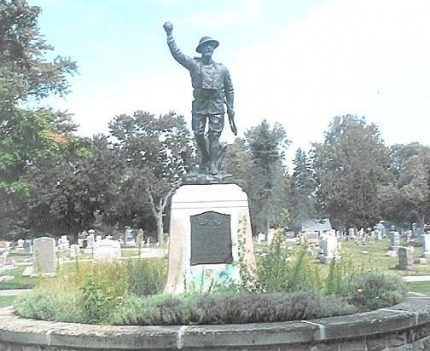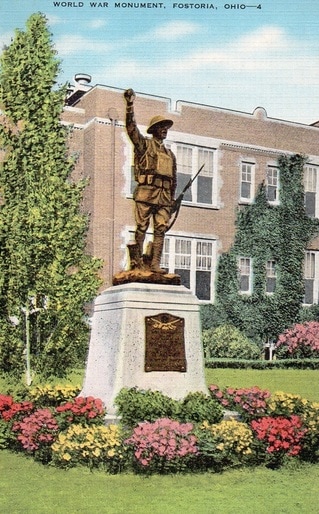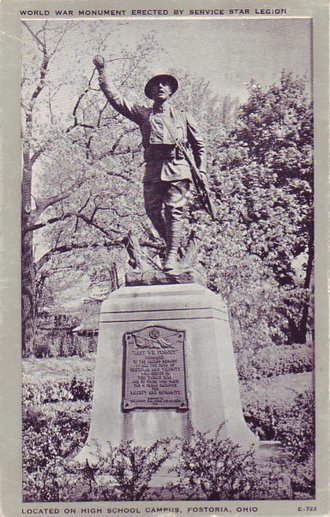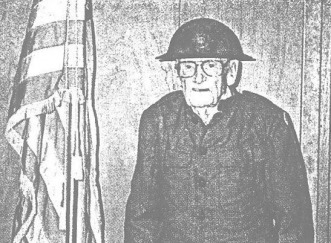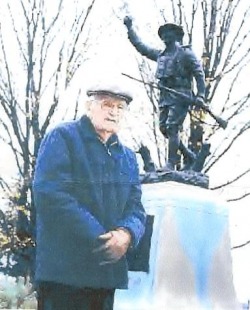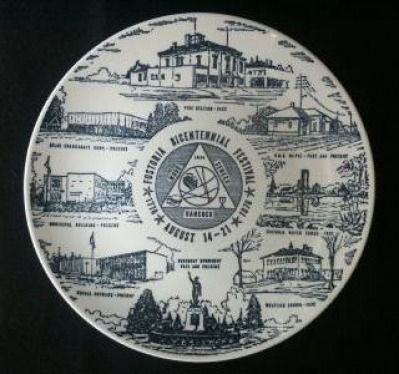FOSTORIA, OHIO
N 41° 09.801 / W 083° 25.749
Copyright version 1920, sheet bronze.
Smithsonian Art Inventory Control Number: 47260078.
Copyright version 1920, sheet bronze.
Smithsonian Art Inventory Control Number: 47260078.
In Fountain Cemetery on Van Buren Street between River Street and Sunset Drive.
The inscription on the plaque on the bases reads:
1917 (Crossed flags) 1918
“LEST WE FORGET”
DEDICATED
TO THE SACRED MEMORY
OF ALL THE BOYS OF
FOSTORIA AND VICINITY
WHO SERVED IN
THE WORLD WAR
AND TO THOSE WHO MADE
THE SUPREME SACRIFICE
FOR
LIBERTY AND HUMANITY
PRESENTED BY
THE SERVICE STAR LEGION WAR MOTHERS
1927
1917 (Crossed flags) 1918
“LEST WE FORGET”
DEDICATED
TO THE SACRED MEMORY
OF ALL THE BOYS OF
FOSTORIA AND VICINITY
WHO SERVED IN
THE WORLD WAR
AND TO THOSE WHO MADE
THE SUPREME SACRIFICE
FOR
LIBERTY AND HUMANITY
PRESENTED BY
THE SERVICE STAR LEGION WAR MOTHERS
1927
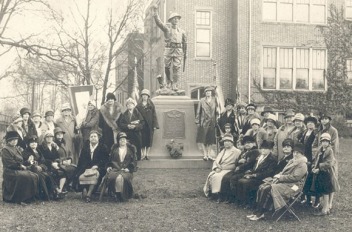
Gold Star Mothers at the 1927 dedication.
Dedicated November 11, 1927 on the grounds of old Fostoria High School with the high school band providing music for the ceremony. Mrs. W. S. Finkbein, state president of the Service Star Legion War Mothers, presented the memorial. Acceptance remarks were given by Fostoria Mayor L. W. Gibson and school board President Fred Freese and Bowling Green Mayor F. J. Reider. Mrs. E. H. Retan, a Gold Star Mother, was escorted to the base of the statue by the color guard of the Service Star Legion and was assisted in the unveiling by a Boy Scout as Taps was played.
* * *
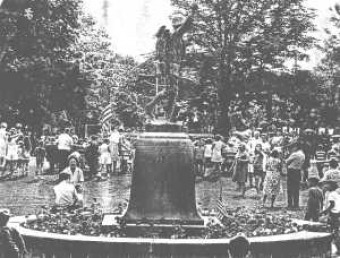
The Doughboy after the 1969 move.
In 1969, the Doughboy, including its pedestal, was moved by moving contractor Ludwig Berwick to Fountain Cemetery and placed inside a circular stone area containing flowers. Damages were repaired, the bayonet was replaced, and the Doughboy was rededicated May 30, 1969.
At right is a Fostoria Review Times picture taken at the time of that ceremony.
At right is a Fostoria Review Times picture taken at the time of that ceremony.
The Doughboy received reasonable maintenance at the cemetery, but the years of exposure to the elements took their toll and a major restoration fundraising campaign was undertaken in 1995 to obtain donations of citizens and of Veteran, Fraternal Civic and other organizations. The restoration was performed under the supervision of Tom Podner, McKay Lodge Fine Arts Conservation Laboratory, Oberlin, Ohio.
Fostorian Frank Kirian provided expert advice during the restoration project. Frank and Royetta Kirian visited over 80 Doughboy sites through the years. They were physically looking for them before T. P. Wesley of Spencer, Indiana sent the 1991 letter to Home and Away magazine to solicit information about their locations. While they didn’t previously know Mr. Wesley and Mr. Wesley didn’t know them, when the Kirians learned of the letter, they took all the photos they had to Mr. Wesley in Spencer. Mr. Wesley told me (Earl Goldsmith) of them the first time we talked – and later told me of the Forstoria restoration mentioned above. They were undoubtedly his favorite Doughboy searchers. and have probably seen more standing Doughboys than anyone.
Below is a transcript of a short piece from the Fostoria Review Times regarding Mr. Kirian’s role in the 1996 restoration. It also mentions T. Perry Wesley.
Fostorian Frank Kirian provided expert advice during the restoration project. Frank and Royetta Kirian visited over 80 Doughboy sites through the years. They were physically looking for them before T. P. Wesley of Spencer, Indiana sent the 1991 letter to Home and Away magazine to solicit information about their locations. While they didn’t previously know Mr. Wesley and Mr. Wesley didn’t know them, when the Kirians learned of the letter, they took all the photos they had to Mr. Wesley in Spencer. Mr. Wesley told me (Earl Goldsmith) of them the first time we talked – and later told me of the Forstoria restoration mentioned above. They were undoubtedly his favorite Doughboy searchers. and have probably seen more standing Doughboys than anyone.
Below is a transcript of a short piece from the Fostoria Review Times regarding Mr. Kirian’s role in the 1996 restoration. It also mentions T. Perry Wesley.
Research key to restoration
Repairing "The Spirit of the American Doughboy" not only required the skills of a metal specialist but also research.
Before work could begin on the statue in Fountain Cemetery, the McKay Lodge Fine Arts Conservation Laboratory, Oberlin, contacted two historians and other conservators on the statue's original condition.
The historians included Frank Kirian, Fostoria, who has traveled the country photographing identical statues, and T. Perry Wesley of Spencer, Ind., a former newspaper editor and authority on the works of sculptor E.M. Viquesney.
The information was used to determine the correct look of the statue and metal composition. Restoration included power washing and chemically treating the statue until the green discoloration was removed, according to a McKay Lodge report. The entire statue also had to be treated with a hot wax which was heated with a propane torch on location. The treatment returned the statue to a bronze, penny brown color, which can be maintained by annual waxing.
Before work could begin on the statue in Fountain Cemetery, the McKay Lodge Fine Arts Conservation Laboratory, Oberlin, contacted two historians and other conservators on the statue's original condition.
The historians included Frank Kirian, Fostoria, who has traveled the country photographing identical statues, and T. Perry Wesley of Spencer, Ind., a former newspaper editor and authority on the works of sculptor E.M. Viquesney.
The information was used to determine the correct look of the statue and metal composition. Restoration included power washing and chemically treating the statue until the green discoloration was removed, according to a McKay Lodge report. The entire statue also had to be treated with a hot wax which was heated with a propane torch on location. The treatment returned the statue to a bronze, penny brown color, which can be maintained by annual waxing.
* * *
The Doughboy was rededicated in appropriate ceremonies November 11, 1996. One of the highlights of the 1996 restoration project was the participation of Albert Thomas, who had served in the European trenches during the war, and was Fostoria’s only surviving World War veteran. He was 100 years old at the time he attended the November 11, 1996 rededication. He had served at Chateau-Thierry France, near Ypres, Belgium, and in the Battle of the Argonne Forest.
The picture above left of Mr. Thomas appeared in the Fostoria Times Review and shows him in 1995 at age 99 in his old World War uniform during the fundraising campaign for the 1996 restoration. The photo at the right shows him at age 102 in 1998 at the Doughboy memorial.
Mr. Thomas passed away at the Good Shepard Home in Fostoria February 20, 2002. He was 105. As Fostoria’s last surviving World War veteran, his passing marked the end of an era.
Mr. Thomas passed away at the Good Shepard Home in Fostoria February 20, 2002. He was 105. As Fostoria’s last surviving World War veteran, his passing marked the end of an era.
For its 1976 bicentennial, the city of Fostoria produced this commemorative plate featuring its Doughboy at the bottom.
All the black-and-white photos and the news article about Mr. Kirian were provided by Penny Justice of the Kaubisch Memorial Library.
